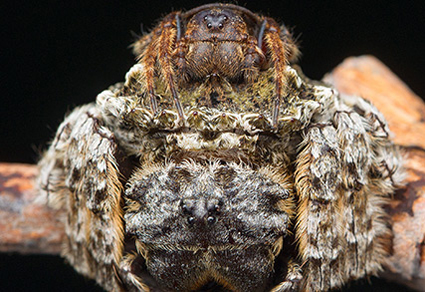Abstract
A unique type of mate guarding behavior is discovered in the araneid spider Caerostris sumatrana Strand, 1915: the male waits for the female’s maturity while staying tied to the dorsal surface of her abdomen. The species is redescribed in detail. General appearance of the male and its fine structures are illustrated by scanning electron microscopy for the first time. Genital emasculation in the male of this species is reported for the first time.
References
- Fairbairn, D.J., Blanckenhorn, W.U. & Szekely, T. (2007) Sex, size, and gender roles: Evolutionary studies of sexual size dimorphism, Oxford University Press, Oxford, 280 pp. https://doi.org/10.1093/acprof:oso/9780199208784.001.0001
- Grasshoff, M. (1984) Die Radnetzspinnen-Gattung Caerostris (Arachnida: Araneae). Revue Zoologique Africaine, 98, 725–765.
- Gregorič, M., Blackledge, T.A., Agnarsson, I. & Kuntner, M. (2015) A molecular phylogeny of bark spiders reveals new species from Africa and Madagascar (Araneae: Araneidae: Caerostris). Journal of Arachnology, 43 (3), 293–312. https://doi.org/10.1636/0161-8202-43.3.293
- Gregorič, M., Šuen, K., Cheng, R.-C., Kralj-Fišer, S. & Kuntner, M. (2016) Spider behaviors include oral sexual encounters. Scientific Reports, 6, 25128. https://doi.org/10.1038/srep25128
- Jäger, P. (2007) Spiders from Laos with descriptions of new species (Arachnida: Araneae). Acta Arachnologica, 56, 29–58. https://doi.org/10.2476/asjaa.56.29
- Kuntner, M. & Agnarsson, I. (2010) Web gigantism in Darwin’s bark spider, a new species from Madagascar (Araneidae: Caerostris). Journal of Arachnology, 38, 346–356. https://doi.org/10.1636/B09-113.1
- Kuntner, M., Agnarsson, I. & Li, D.Q. (2015) The eunuch phenomenon: adaptive evolution of genital emasculation in sexually dimorphic spiders. Biological Reviews, 90, 279–296. https://doi.org/10.1111/brv.12109
- Shorthouse, D.P. (2010) SimpleMappr, an online tool to produce publication-quality point maps. http://www.simplemappr.net (accessed 18 April 2023)
- Simon, E. (1895) Histoire naturelle des araignées. Tome Premier. Deuxième Edition. Roret, Paris, pp. 761–1084. https://doi.org/10.5962/bhl.title.51973
- Song, D.X., Zhu, M.S. & Chen, J. (1999) The spiders of China. Hebei Science and Technology Publishing House, Shijiazhuang, 640 pp.
- Thorell, T. (1868) Araneae. Species novae minusve cognitae. In: Virgin, C.A. (Ed.), Kongliga Svenska Fregatten Eugenies Resa omkring Jorden, Uppsala, Zoologi, Arachnida, 1868, pp. 1–34.
- Wilder, S.M., Rypstra, A.L. & Elgar, M.A. (2009) The importance of ecological and phylogenetic conditions for the occurrence and frequency of sexual cannibalism. Annual Review of Ecology, Evolution, and Systematics, 40, 21–39. https://doi.org/10.1146/annurev.ecolsys.110308.120238
- World Spider Catalog (2023) World Spider Catalog. Natural History Museum Bern. Version 24.0. Available from: http://wsc.nmbe.ch (accessed 7 May 2022) https://doi.org/10.24436/2


